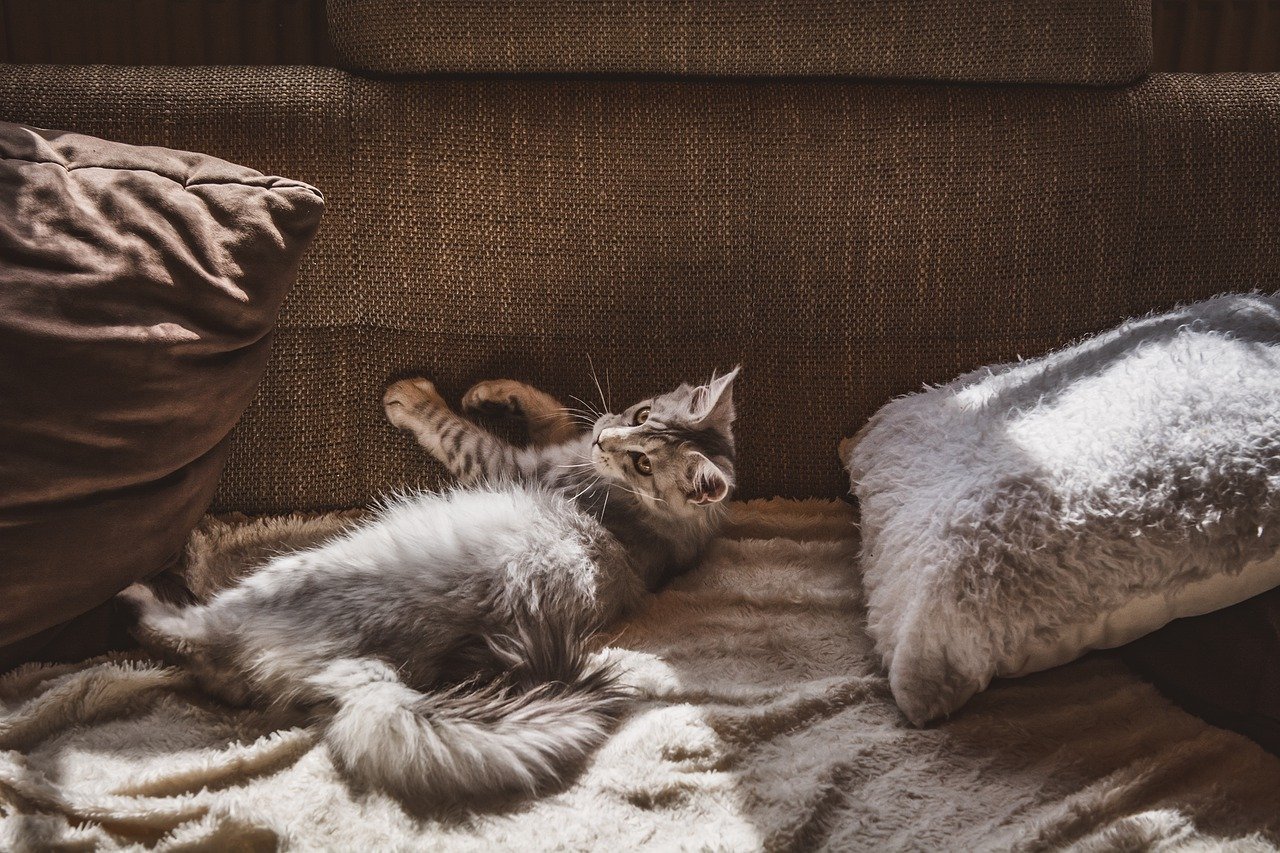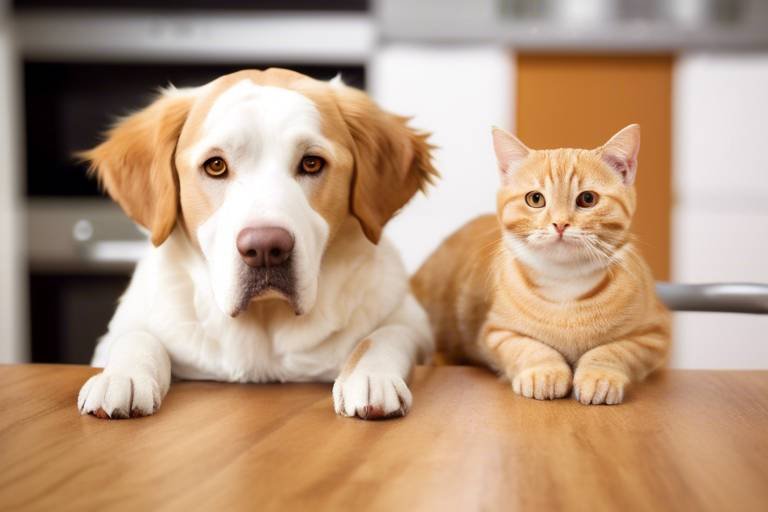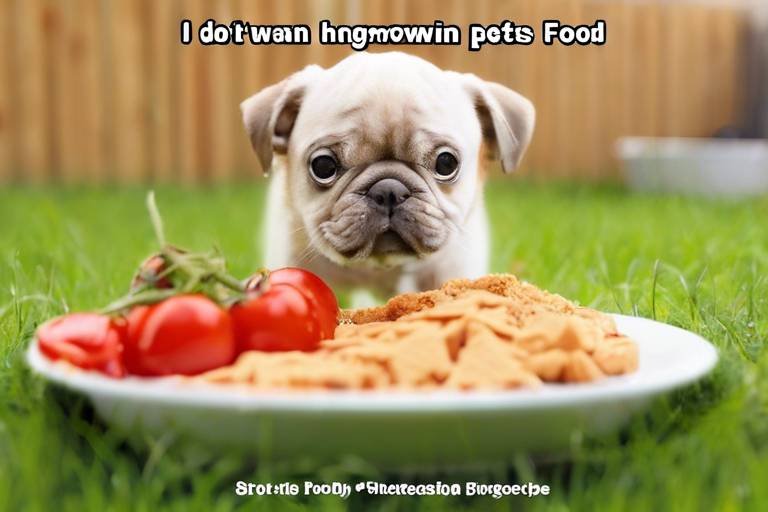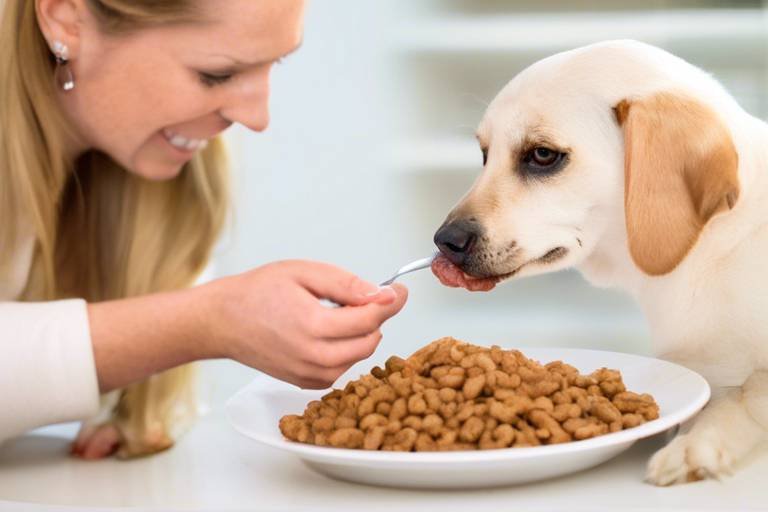Understanding the Risks of Overfeeding Treats
When it comes to our furry friends, we often want to shower them with love, and what better way to do that than with treats? However, it's essential to understand that while treats can bring immense joy to our pets, overindulgence can lead to serious health risks. Think of treats as the frosting on a cake; they’re delightful but should never be the main course. In this article, we’ll explore the various risks associated with overfeeding treats, emphasizing the importance of moderation and balanced nutrition to maintain their health and well-being.
Many pet owners might not realize that most commercial treats are often loaded with sugars, fats, and preservatives, lacking the essential nutrients that our pets need for a balanced diet. This lack of nutritional value can lead to a variety of health issues over time. Just like humans, pets thrive on a diet rich in vitamins, minerals, and proteins. If treats are taking up too much space in their diet, they might be missing out on these vital nutrients. So, how do we find the right balance? Let’s dive deeper into the nutritional impact of treats and the health risks associated with their overconsumption.
Excessive treat consumption can lead to a cascade of health problems. Obesity is perhaps the most visible issue, but it doesn’t stop there. Pets can develop diabetes, joint problems, and even heart disease as a result of being overfed. Imagine your pet as a car; if you keep pouring in fuel without considering the right type and amount, eventually, the engine will struggle. Recognizing these risks is crucial for responsible pet ownership and maintaining a healthy lifestyle for our beloved companions.
As we navigate the world of pet treats, it’s vital to remember that moderation is key. Just like we wouldn't want to eat an entire cake in one sitting, our pets shouldn't be indulging in treats excessively. In the following sections, we’ll discuss strategies for managing treat intake, identifying healthier options, and ensuring that our pets enjoy their treats without compromising their health.
Before we jump into the health risks, let’s take a moment to understand the nutritional impact of treats. Treats can certainly bring joy to our pets, but it’s essential to ask ourselves: what are we really feeding them? Many treats are designed to be tasty and enticing, but they often lack the essential nutrients that contribute to a balanced diet. By understanding the nutritional value of the treats we choose, we can make informed decisions that support our pet's overall health.
In conclusion, while treats can be a delightful addition to our pets’ lives, it’s crucial to keep their consumption in check. By focusing on moderation, choosing healthier options, and integrating treats thoughtfully into their diets, we can ensure that our furry friends remain happy and healthy. Remember, a little love in the form of treats goes a long way, but too much can lead to unforeseen consequences.
- How many treats can I give my pet daily? - The number of treats varies by pet size and dietary needs, but generally, treats should not exceed 10% of their daily caloric intake.
- Are there healthy treat options available? - Yes! Look for treats made with natural ingredients, low in sugar and fat, or consider fruits and vegetables suitable for pets.
- What should I do if my pet is overweight? - Consult your veterinarian for a tailored diet plan and consider reducing treat intake while increasing physical activity.

The Nutritional Impact of Treats
Treats can be a delightful addition to your pet's diet, offering them a moment of joy and excitement. However, it’s essential to remember that not all treats are created equal. While they can provide enjoyment, many commercial pet treats are often high in calories and low in essential nutrients. This imbalance can lead to nutritional deficiencies if treats constitute a significant portion of your pet's diet. It's like giving a child candy instead of a balanced meal; they might love it, but it won't help them grow strong and healthy.
Understanding the nutritional value of the treats you choose is crucial. Many treats are packed with sugars, artificial flavors, and preservatives that offer little to no health benefits. For instance, a popular brand of dog biscuits might be marketed as a treat, but a quick glance at the ingredient list could reveal that it contains more fillers than actual nutrients. This is why it's important for pet owners to scrutinize the labels and ensure that the treats they give are not just tasty but also nutritious.
To provide a clearer picture, here’s a simple comparison of typical treat types and their nutritional content:
| Treat Type | Calories per Treat | Protein Content | Fat Content |
|---|---|---|---|
| Commercial Biscuits | 30 | 2g | 1g |
| Raw Vegetables (Carrots) | 10 | 0.5g | 0g |
| Homemade Peanut Butter Treats | 50 | 3g | 3g |
As seen in the table, some treats can be quite calorically dense without providing much in terms of nutrition. This highlights the importance of moderation and making informed choices. Instead of relying solely on commercial treats, consider incorporating healthier alternatives. Fresh fruits and vegetables can serve as excellent low-calorie treats, providing essential vitamins and minerals that contribute to your pet's overall health.
In conclusion, while treats can be a fun and rewarding part of your pet's life, they should not replace a balanced diet. By understanding the nutritional impact of the treats you offer, you can ensure that your furry friend enjoys their goodies without compromising their health. Remember, just like us, pets thrive on a variety of foods that provide the nutrients they need to live a happy and active life.
- How many treats should I give my pet daily? - It's best to limit treats to no more than 10% of your pet's daily caloric intake.
- Are all treats bad for pets? - Not all treats are bad; opt for those that are low in calories and high in nutrients.
- Can I give my pet human food as treats? - Yes, but ensure the food is safe for pets. Foods like carrots, apples, and peanut butter (in moderation) can be great options.

Health Risks Associated with Overfeeding
When it comes to our furry friends, we often find ourselves showering them with love, and what better way to express that love than through treats? However, the joy of treat-giving can quickly turn into a slippery slope of health issues if we're not careful. Overfeeding treats can lead to a myriad of health problems that can seriously affect your pet's quality of life. Imagine your pet as a balloon; a little air is fine, but too much can lead to a pop! Similarly, too many treats can lead to serious health risks, and it's essential for pet owners to be aware of these dangers.
One of the most alarming consequences of overfeeding is obesity. Did you know that nearly 60% of pets in the United States are considered overweight or obese? This staggering statistic highlights the need for greater awareness among pet owners. Obesity can lead to a host of other health issues, including:
- Diabetes: Just like in humans, excess weight can lead to insulin resistance in pets, resulting in diabetes.
- Joint Problems: Extra weight puts additional strain on joints, leading to arthritis and mobility issues.
- Heart Disease: Obesity can increase the risk of heart conditions, shortening your pet's lifespan.
But obesity is just the tip of the iceberg. Overfeeding treats can also lead to behavioral problems. Pets that are constantly rewarded with treats may develop a habit of begging or become aggressive about food. This can create an unhealthy relationship with food, where your pet begins to see treats as a right rather than a reward. Think about it: if someone were to hand you a cookie every time you asked for one, you might start to expect it, right? Similarly, pets can develop unrealistic expectations around food.
Moreover, the type of treats you’re giving can also play a significant role in your pet's health. Many commercial treats are loaded with artificial ingredients and fillers, which can lead to digestive issues or allergies. It's crucial to read labels and choose treats that are not just tasty but also beneficial to your pet's health. If you're unsure, consulting with a veterinarian can provide valuable insights into what treats are appropriate.
In summary, while treats are a delightful way to bond with your pet, moderation is key. Overfeeding can lead to obesity, diabetes, joint problems, and behavioral issues. As responsible pet owners, it’s our duty to ensure that our pets enjoy their treats without compromising their health. After all, a happy pet is a healthy pet!
Q: How many treats can I give my pet daily?
A: A general rule of thumb is that treats should make up no more than 10% of your pet's daily caloric intake. Always consult your veterinarian for personalized advice.
Q: Are there any healthy treat options?
A: Yes! Look for treats made from natural ingredients, or consider fruits and vegetables like carrots or apple slices as healthy alternatives.
Q: What should I do if my pet is overweight?
A: Consult with your veterinarian to create a weight management plan that includes a balanced diet and regular exercise.
Obesity and Weight Management
Obesity in pets is not just a cute little problem; it’s a serious health concern that can lead to a multitude of issues, from joint pain to diabetes. Imagine your furry friend struggling to keep up with their playful antics because they’ve had too many treats! It’s a heartbreaking sight, and as responsible pet owners, we need to tackle this issue head-on. The first step is understanding that treats should only make up a small fraction of your pet's daily caloric intake. In fact, a good rule of thumb is that treats should not exceed 10% of their daily calories.
To manage your pet's weight effectively, it’s essential to combine a balanced diet with regular exercise. Think of it like a seesaw: one side is nutrition while the other is physical activity. If one side is heavier, the seesaw tips, and your pet's health can suffer. A well-rounded diet rich in essential nutrients will provide the energy they need for play while keeping them satisfied. Regular vet check-ups can help you monitor your pet’s weight and adjust their diet accordingly. Remember, it’s not just about cutting back on treats; it’s about finding that sweet spot where your pet can enjoy their favorite snacks without tipping the scale.
Here are some effective strategies to manage your pet's weight while still allowing for those occasional tasty rewards:
- Measure Treats: Use a measuring cup to portion out treats. It’s easy to underestimate how many we give, especially when those puppy eyes are staring at us!
- Substitute Wisely: Consider healthier alternatives to traditional treats. For example, carrot sticks or apple slices can be a crunchy delight without the extra calories.
- Schedule Treats: Instead of giving treats throughout the day, schedule specific times for them. This helps create a routine and allows your pet to anticipate their rewards.
By being mindful of what and how much we feed our pets, we can help them lead healthier, happier lives. Just like humans, pets can struggle with weight management, but with a little dedication and the right strategies, we can help them maintain a healthy lifestyle. After all, a healthy pet is a happy pet!
Q: How do I know if my pet is overweight?
A: You can check by feeling their ribs; you should be able to feel them without too much pressure. If you can’t, it might be time for a diet adjustment!
Q: Can I give my pet human food as treats?
A: Yes, but be cautious! Some human foods are safe, like carrots and apples, while others, like chocolate and grapes, can be toxic.
Q: How often should I take my pet to the vet for weight checks?
A: Ideally, you should schedule a vet visit at least once a year, but if your pet is overweight, more frequent visits may be necessary.
Identifying Healthy Treat Options
When it comes to pampering our beloved pets, treats are often the go-to choice. However, not all treats are created equal, and identifying healthy options is crucial for maintaining your pet's health. Just like humans, pets can benefit from nutritious snacks that not only satisfy their cravings but also support their overall well-being.
First, let’s talk about what makes a treat healthy. Look for treats that are made from natural ingredients and avoid those with artificial additives, preservatives, and fillers. A good rule of thumb is to check the ingredient list. If you can’t pronounce it or if it sounds more like a chemistry experiment than food, it’s best to steer clear. Instead, opt for treats that feature whole foods like meat, fruits, and vegetables.
For example, consider treats that contain ingredients like sweet potatoes, pumpkin, or even blueberries. These options not only taste great but also provide essential vitamins and antioxidants that can contribute to your pet's health. You might be surprised to learn that some pets enjoy homemade treats just as much, if not more, than store-bought ones. You can easily whip up a batch of peanut butter and oat biscuits or freeze some plain yogurt with fruit for a refreshing snack!
It’s also essential to think about the caloric content of the treats you choose. Just like humans, pets can gain weight from excessive calorie consumption, even if those calories come from what seems like harmless treats. A great way to manage this is by incorporating treats into your pet’s daily caloric intake. For instance, if your dog’s daily calorie requirement is 500 calories, and you plan to give them a treat that has 50 calories, you should adjust their regular food intake accordingly.
To help you navigate the world of healthy pet treats, here’s a quick comparison of some popular treat options:
| Treat Type | Ingredients | Health Benefits |
|---|---|---|
| Sweet Potato Chews | 100% sweet potato | High in fiber and vitamins |
| Chicken Jerky | Real chicken, no preservatives | Protein-rich, good for muscle health |
| Fruit and Veggie Bites | Carrots, apples, blueberries | Antioxidants and vitamins |
In addition to choosing the right ingredients, pay attention to the size and texture of the treats. Smaller, softer treats can be ideal for training sessions, while larger, crunchier options can keep your pet occupied for longer periods. This not only helps in maintaining their dental health but also engages their natural chewing instincts.
Lastly, always keep in mind that moderation is key. Even the healthiest treats should be given in appropriate amounts. A good practice is to reserve treats for special occasions or as rewards for good behavior. This way, your pet will appreciate them even more when they do receive one!
- What are some healthy homemade treat recipes for pets? You can make simple recipes using ingredients like oats, peanut butter, and mashed bananas. Just mix them together, shape them, and bake!
- How many treats can I give my pet daily? A good rule of thumb is that treats should not exceed 10% of your pet's daily caloric intake.
- Are there any treats I should avoid? Yes, avoid treats with artificial ingredients, high sugar content, or those containing chocolate, grapes, and onions, as these can be toxic to pets.
Portion Control Techniques
When it comes to keeping your furry friends healthy, portion control is a game changer! Just like we humans need to be mindful of our food intake, pets require the same level of attention, especially when it comes to treats. It's all too easy to get carried away and shower them with goodies, but this can lead to serious health issues. So, how can we ensure our pets enjoy their treats without going overboard? Let’s dive into some effective techniques!
First off, understanding the right serving size for your pet is crucial. Each treat has a different caloric value, and knowing how they fit into your pet's daily caloric needs will help you make informed decisions. For example, if your pet's total daily caloric intake should be around 500 calories, and you give them treats that amount to 100 calories, you need to adjust their regular meals accordingly. This balance is key!
One effective technique is to use a measuring cup or a kitchen scale. By measuring out treats, you can avoid the temptation of just tossing a handful into their bowl. You might be surprised at how quickly those calories can add up! For instance, if you typically give your dog five treats a day without measuring, consider how many calories that actually represents. Taking the time to measure can help you stay within healthy limits.
Another useful strategy is to incorporate treats into their meals. Instead of giving treats separately, try mixing a few into their regular food. This not only makes their meal more exciting but also helps you control the overall quantity. You can even use treats as a reward during training sessions, which can also be a great way to bond with your pet while keeping their treat intake in check.
Moreover, consider using low-calorie treats or healthy alternatives. For example, fresh fruits and vegetables like carrots or apple slices can be a crunchy, satisfying option that won’t pack on the pounds. You can even prepare homemade treats, controlling the ingredients and portion sizes. This way, you know exactly what your pet is consuming, and you can feel good about their snack time!
Lastly, it's essential to establish a routine. By setting specific times for treats, you can avoid the habit of giving them out randomly throughout the day. This not only helps with portion control but also teaches your pet to anticipate their treat times, making them even more special. Remember, consistency is key in training and maintaining a healthy lifestyle for your pet!
By implementing these portion control techniques, you can ensure your pet enjoys their treats without jeopardizing their health. It’s all about finding that perfect balance between indulgence and responsibility. After all, our pets deserve the best, and keeping them healthy is the greatest treat of all!
- How many treats can I give my pet in a day? The general rule is that treats should make up no more than 10% of your pet's daily caloric intake. Always consult your veterinarian for tailored advice.
- Can I use regular food as treats? Absolutely! You can use small pieces of your pet's regular food or healthy snacks like fruits and veggies as treats.
- What are some low-calorie treat options? Consider options like carrots, green beans, or specially formulated low-calorie treats available at pet stores.
Behavioral Effects of Treat Overfeeding
Overfeeding treats to our beloved pets might seem harmless at first, but it can lead to a range of behavioral issues that can disrupt the harmony of your household. Imagine your pet, once a joyful and playful companion, suddenly transforming into a demanding little tyrant, constantly begging for more treats. This scenario is not uncommon and highlights the importance of moderation in treat-giving. When pets are given too many treats, they may develop unwanted behaviors that can be challenging to manage.
One of the most noticeable effects of treat overfeeding is the development of begging behavior. Pets quickly learn that by whining, pawing, or staring longingly at their owners, they can score some extra snacks. This behavior not only becomes annoying but can also lead to a cycle where the pet feels entitled to treats, further exacerbating the problem. Imagine your pet sitting by the dinner table, giving you those big puppy eyes, and you just can’t resist! However, giving in to those pleas can reinforce the behavior, making it harder to break the cycle.
Another serious issue that can arise is food aggression. When pets are overfed treats, they may start to guard their food and treats more aggressively, fearing that their supply will be taken away. This can lead to dangerous situations, especially in multi-pet households. To illustrate, picture two dogs in the same household: if one feels that treats are scarce, it may growl or snap at the other, creating tension and fear. This behavior can escalate if not addressed promptly, leading to potential harm to both pets and humans.
Furthermore, overfeeding can result in a lack of motivation for exercise. Pets that are accustomed to receiving treats for every little good behavior may become lazy, opting for a nap on the couch instead of a fun game of fetch. This not only affects their physical health but also their mental stimulation. Pets need to engage their minds and bodies, and when treats are given too freely, they may lose interest in other activities. It’s like giving a child candy all day; they might not want to eat their vegetables anymore!
To combat these behavioral issues, it's essential to set boundaries and establish a treat schedule. Here are some tips to help manage treat-related behaviors:
- Limit the number of treats given each day.
- Use treats as rewards for specific behaviors, rather than as a constant supply.
- Incorporate playtime or exercise as a reward instead of treats.
- Teach your pet commands like “leave it” to discourage begging.
In conclusion, while treats can be a wonderful way to show love and appreciation for our pets, it’s crucial to be mindful of how much we give. Overfeeding can lead to a host of behavioral problems that can strain the bond between you and your furry friend. By practicing moderation and creating a structured approach to treat-giving, you can help ensure that your pet remains happy, healthy, and well-behaved.
Q: How many treats should I give my pet daily?
A: The number of treats depends on your pet's size, age, and activity level. A general guideline is to limit treats to no more than 10% of their daily caloric intake.
Q: Can I use treats for training?
A: Absolutely! Treats can be an effective training tool. Just ensure that the treats are small and healthy, and account for them in your pet's daily food intake.
Q: What should I do if my pet begs for treats?
A: Ignore the begging behavior at first, and only give treats when your pet is calm and not demanding. Consistency is key to breaking the habit.

Establishing a Balanced Diet
Creating a balanced diet for your furry friend is essential for their overall health and longevity. It's not just about filling their bowl with food; it's about ensuring they receive a variety of nutrients that support their well-being. Think of your pet's diet like a well-composed symphony—each ingredient plays a vital role in the harmony of their health. A balanced diet should include high-quality protein, healthy fats, carbohydrates, vitamins, and minerals.
When we talk about a balanced diet, it’s crucial to remember that treats are just that—treats. They should complement your pet’s main meals rather than replace them. Pet owners often fall into the trap of thinking that giving their pets an abundance of treats is a way to show love. However, too many treats can lead to nutritional imbalances and health issues. Instead, consider treats as an occasional bonus, much like dessert for us humans!
To establish a balanced diet, start by consulting with your veterinarian. They can provide personalized dietary recommendations based on your pet's age, weight, activity level, and health conditions. Here’s a simple breakdown of what to include in your pet's diet:
| Food Group | Examples | Nutritional Benefits |
|---|---|---|
| Proteins | Chicken, Fish, Beef | Supports muscle development and overall energy |
| Carbohydrates | Brown Rice, Sweet Potatoes | Provides energy and aids digestion |
| Fats | Fish Oil, Flaxseed | Promotes healthy skin and coat |
| Vitamins & Minerals | Fruits, Vegetables | Supports immune function and overall health |
Integrating a variety of foods into your pet's meals not only keeps them excited about their food but also ensures they receive all the essential nutrients they need. You might wonder how to incorporate treats without overdoing it. Here are a few tips:
- Use treats as a reward for good behavior during training sessions.
- Consider treating your pet with small pieces of fruits or vegetables that are safe for them.
- Limit treat portions to no more than 10% of their daily caloric intake.
Establishing a balanced diet is not a one-time task but an ongoing process. Regularly evaluate your pet's weight and health, and adjust their diet as needed. Remember, a healthy pet is a happy pet, and a balanced diet is the foundation of a long, fulfilling life together.
Q: How often should I feed my pet treats?
A: Treats should be given sparingly, ideally making up no more than 10% of your pet's daily caloric intake.
Q: Can I use human food as treats?
A: Yes, but ensure that the food is safe for pets. Fruits like apples and bananas or veggies like carrots are great options.
Q: How do I know if my pet is overweight?
A: You can check by feeling your pet's ribs. If you can't feel them easily, your pet may be overweight. Consult your vet for a proper assessment.
Integrating Treats into Daily Meals
Integrating treats into your pet's daily meals can be a delightful way to enhance their dining experience without compromising their health. It’s like adding a sprinkle of magic to their bowl! However, this must be done thoughtfully. The key here is moderation and balance. Just like we enjoy a slice of cake on special occasions, our furry friends can enjoy treats, but they should never overshadow their main meals.
One effective strategy is to incorporate treats as part of their regular feeding routine. For example, you can use treats as a reward for good behavior during mealtime, making them feel special without overindulging. Consider breaking treats into smaller pieces and mixing them with their regular food. This not only enhances the flavor but also makes mealtime more exciting for your pet. It’s like turning their everyday meal into a gourmet feast!
Another approach is to use treats as a way to promote healthy eating habits. For instance, if your pet is a picky eater, you can sprinkle a few enticing treats on top of their food to encourage them to dig in. This can be especially helpful for dogs or cats who may be reluctant to eat their kibble. However, it’s crucial to keep track of the total caloric intake to ensure that the treats do not exceed 10% of their daily caloric needs. Think of it as a little bonus rather than a meal replacement.
To make things easier, here’s a simple table to help you understand how to balance treats with their daily meals:
| Pet Weight (lbs) | Daily Caloric Needs | Max Treat Calories (10%) |
|---|---|---|
| 10 | 200 | 20 |
| 20 | 400 | 40 |
| 30 | 600 | 60 |
| 40 | 800 | 80 |
Additionally, consider the timing of treats. Offering treats after a walk or play session can reinforce positive behavior and create a strong bond between you and your pet. It’s rewarding for them and strengthens your relationship. But remember, always choose healthy options! Treats should complement a balanced diet, not replace it. Think of treats as the icing on the cake, not the cake itself!
In summary, integrating treats into your pet's daily meals can be a fun and rewarding experience, but it requires careful planning and consideration. By following these guidelines, you can ensure that your pet enjoys their treats while maintaining a healthy diet. This balance is essential for their overall well-being, and it can lead to a happier, healthier pet!
- How many treats can I give my pet each day? - Generally, treats should not exceed 10% of your pet's daily caloric intake.
- What are some healthy treat options? - Look for treats that are low in calories and made from natural ingredients, such as fruits or vegetables.
- Can I use treats for training purposes? - Absolutely! Treats can be a great motivator during training sessions.
- Is it better to give treats before or after meals? - It depends on your pet's habits, but offering them after meals can reinforce good behavior.
Consulting with a Veterinarian
When it comes to the health and well-being of your furry friend, consulting with a veterinarian is not just a good idea; it's essential! Think of your vet as the trusted guide on your pet's journey through life. They possess a wealth of knowledge about nutrition, behavior, and health issues that can arise from improper feeding practices. But why should you prioritize these consultations, especially regarding treat consumption? Well, let’s dive into it!
First and foremost, a veterinarian can provide personalized dietary advice tailored specifically to your pet's needs. Every pet is unique, and what works for one might not work for another. Factors such as age, weight, breed, and activity level play significant roles in determining the right diet. For example, a high-energy puppy will have different nutritional requirements compared to a senior dog with arthritis. A vet can help you understand these differences and guide you in making the best choices for your pet.
Moreover, regular check-ups allow your vet to monitor your pet's health over time. This ongoing relationship can be invaluable in identifying any potential issues early on. If your pet is gaining weight due to excessive treat consumption, your veterinarian can help you create a plan to adjust their diet and lifestyle. They might suggest alternatives or modifications, such as switching to lower-calorie treats or incorporating more exercise into your pet's routine.
Another crucial aspect is that your veterinarian can educate you on the nutritional value of different treats. Not all treats are created equal! Some may be packed with sugars and fillers, while others are rich in essential nutrients. Your vet can help you navigate this landscape, pointing you towards healthier options that won’t compromise your pet’s health. They might even provide you with a list of recommended treats that align with your pet's dietary needs.
Additionally, if you’re considering homemade treats, your veterinarian can guide you on safe ingredients and portion sizes. It's easy to assume that all human food is safe for pets, but that’s a common misconception. Certain foods, like chocolate and grapes, can be toxic to animals. Your vet can help you understand what ingredients are safe and how to prepare treats that are both delicious and nutritious.
Finally, don’t forget to ask your veterinarian about behavioral concerns related to treat consumption. Overfeeding can lead to behavioral problems such as begging, food aggression, or even obesity-related issues like joint pain. By consulting with your vet, you can develop strategies to manage these behaviors effectively.
In summary, consulting with a veterinarian is a vital step in ensuring your pet's diet remains healthy and balanced. They provide personalized advice, monitor health, educate on nutrition, and help address behavioral issues. So, the next time you think about giving your pet a treat, remember that a quick chat with your vet can make all the difference in your furry friend's life!
- How often should I consult with my veterinarian about my pet's diet? It's recommended to have regular check-ups at least once a year, but more frequent visits may be necessary if your pet has specific dietary concerns.
- Can I give my pet human food as treats? Some human foods are safe, but always consult your vet to ensure they are appropriate and to avoid toxic ingredients.
- What should I do if my pet is overweight? Speak with your veterinarian about creating a weight management plan, which may include adjusting diet and increasing exercise.
Frequently Asked Questions
- What are the risks of overfeeding treats to my pet?
Overfeeding treats can lead to serious health issues such as obesity, diabetes, and dental problems. Just like humans, pets can suffer from weight-related diseases if they consume too many high-calorie treats. It's crucial to keep an eye on their overall diet and ensure treats are given in moderation.
- How can I identify healthy treat options for my pet?
Look for treats that are low in calories and made from high-quality ingredients. Check the labels for essential nutrients and avoid those with artificial additives. You might also consider fruits and vegetables like carrots or apple slices as healthy alternatives that can satisfy your pet's cravings without the extra calories.
- What portion control techniques can I use?
One effective method is to set a daily limit for treats based on your pet's size and dietary needs. Use measuring cups or a kitchen scale to ensure you're not overindulging them. Additionally, consider using treats as part of their daily food allowance, so you can balance their diet without going overboard.
- Can overfeeding treats affect my pet's behavior?
Absolutely! Pets that are overfed treats may develop behavioral issues such as begging or food aggression. It's essential to establish boundaries and use treats sparingly to prevent these problems. Consistency in training and feeding can help maintain a positive behavior in your furry friend.
- How can I integrate treats into my pet's daily meals?
Integrating treats into meals can be done by substituting a small portion of their regular food with treats or using them as rewards for good behavior during training sessions. Just remember to keep track of the total caloric intake to maintain a balanced diet.
- Why is it important to consult with a veterinarian about my pet's diet?
Veterinarians can provide personalized dietary advice based on your pet's specific health needs and lifestyle. Regular check-ups ensure that you’re on the right track with their nutrition and help you make informed decisions about treat consumption and overall diet.



















